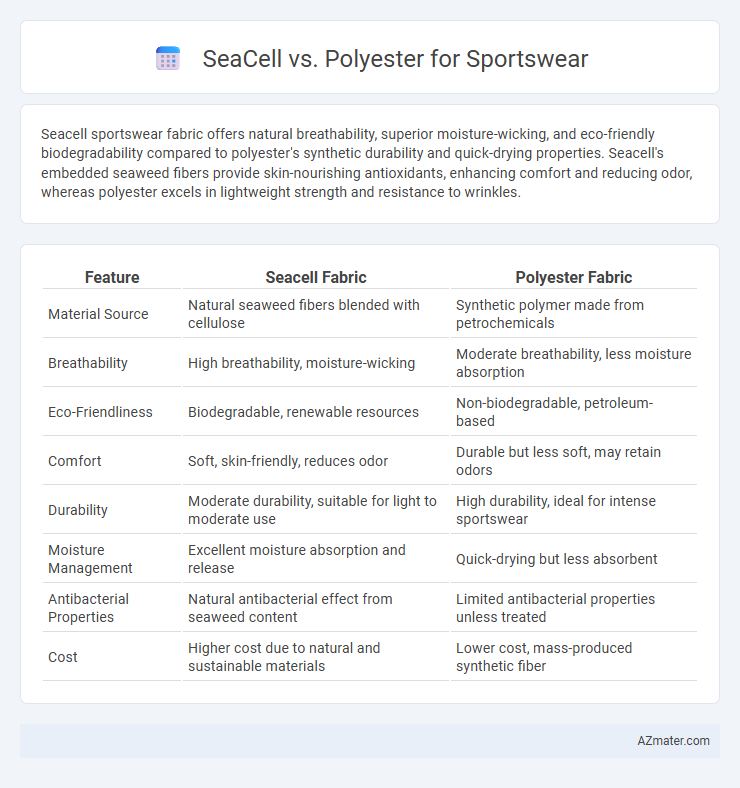Seacell sportswear fabric offers natural breathability, superior moisture-wicking, and eco-friendly biodegradability compared to polyester's synthetic durability and quick-drying properties. Seacell's embedded seaweed fibers provide skin-nourishing antioxidants, enhancing comfort and reducing odor, whereas polyester excels in lightweight strength and resistance to wrinkles.
Table of Comparison
| Feature | Seacell Fabric | Polyester Fabric |
|---|---|---|
| Material Source | Natural seaweed fibers blended with cellulose | Synthetic polymer made from petrochemicals |
| Breathability | High breathability, moisture-wicking | Moderate breathability, less moisture absorption |
| Eco-Friendliness | Biodegradable, renewable resources | Non-biodegradable, petroleum-based |
| Comfort | Soft, skin-friendly, reduces odor | Durable but less soft, may retain odors |
| Durability | Moderate durability, suitable for light to moderate use | High durability, ideal for intense sportswear |
| Moisture Management | Excellent moisture absorption and release | Quick-drying but less absorbent |
| Antibacterial Properties | Natural antibacterial effect from seaweed content | Limited antibacterial properties unless treated |
| Cost | Higher cost due to natural and sustainable materials | Lower cost, mass-produced synthetic fiber |
Introduction to Seacell and Polyester in Sportswear
Seacell is a sustainable fabric derived from seaweed and cellulose, known for its breathability, moisture-wicking properties, and natural antioxidant benefits, making it ideal for eco-friendly sportswear. Polyester, a synthetic polymer widely used in athletic apparel, offers high durability, quick-drying capabilities, and excellent stretch, supporting intense physical activities. Comparing Seacell and Polyester highlights the trade-off between natural, skin-friendly materials and high-performance synthetic fibers in sportswear design.
Material Composition: Seacell vs Polyester
Seacell sportswear features a unique blend of cellulose fibers derived from sustainable seaweed and natural fabrics, offering enhanced breathability and moisture-wicking properties. Polyester, made from synthetic polyethylene terephthalate (PET) fibers, excels in durability, quick-drying capabilities, and resistance to stretching and shrinking. The natural composition of Seacell provides eco-friendly benefits and skin-soothing effects, while polyester's synthetic makeup delivers superior strength and long-lasting performance in high-intensity sports activities.
Moisture Management and Breathability
Seacell fabric, derived from seaweed fibers, exhibits superior moisture management by actively absorbing sweat and releasing skin-nourishing minerals, enhancing comfort during physical activity. Polyester sportswear excels in quick-drying properties and efficient moisture wicking, drawing sweat away from the skin to the garment's surface for rapid evaporation. While Seacell offers natural breathability and skin benefits, polyester remains the preferred choice for high-performance sportswear due to its durability and advanced moisture control technology.
Comfort and Skin Sensitivity
Seacell fabric, embedded with seaweed fibers, offers superior moisture-wicking and natural antibacterial properties, making it ideal for sensitive skin during intense sports activities. Polyester, while durable and quick-drying, can trap heat and cause irritation in those prone to skin sensitivities. Athletes valuing comfort and skin health often prefer Seacell for its hypoallergenic benefits and enhanced breathability.
Durability and Longevity
Seacell fabric, infused with seaweed fibers, offers moderate durability but excels in providing natural breathability and moisture-wicking properties suited for sportswear. Polyester, a synthetic fiber, demonstrates superior durability and longevity, resisting abrasion, stretching, and repeated washing, making it ideal for high-performance athletic apparel. Choosing polyester ensures extended garment life under rigorous sports conditions, while Seacell emphasizes eco-friendly comfort over maximum durability.
Sustainability and Environmental Impact
Seacell fibers, derived from renewable seaweed and cellulose, offer a sustainable alternative to conventional polyester, which is petrochemical-based and contributes significantly to microplastic pollution. Seacell's biodegradable properties reduce long-term environmental impact, while polyester's durability often results in extended landfill persistence and higher carbon emissions during production. Choosing Seacell for sportswear promotes eco-friendly practices by utilizing renewable resources and minimizing plastic waste in aquatic and terrestrial ecosystems.
Anti-Odor and Antibacterial Properties
Seacell fabric, infused with seaweed fibers, naturally enhances sportswear with strong antibacterial and anti-odor properties by inhibiting bacterial growth and reducing sweat-related odors. Polyester, while durable and moisture-wicking, lacks inherent antibacterial qualities and often requires chemical treatments to achieve similar odor control. Athletes seeking sustainable and effective odor management benefit more from Seacell's bioactive compounds compared to conventional polyester materials.
Performance in Athletic Activities
Seacell fabric excels in moisture management and breathability, making it ideal for high-intensity athletic activities by keeping the skin dry and reducing odor with its natural seaweed fibers. Polyester is known for durability and quick-drying properties, offering strong resistance to stretching and abrasion during rigorous workouts, but it may trap heat and moisture compared to Seacell. Athletes seeking comfort and enhanced skin health often prefer Seacell, while those prioritizing longevity and structural support in sportswear may opt for polyester blends.
Care and Maintenance Differences
Seacell sportswear requires gentle washing with mild detergents to preserve its natural fiber properties and avoid fabric degradation, while polyester is more durable and can withstand machine washing and high-temperature drying without significant wear. Seacell's biodegradable fibers need air drying to maintain softness and elasticity, whereas polyester offers quick-drying, wrinkle-resistant qualities ideal for active use. Regular care for Seacell garments enhances their eco-friendly benefits, contrasting with polyester's low-maintenance, synthetic fiber resilience.
Conclusion: Choosing the Best Fabric for Sportswear
Seacell offers natural moisture-wicking properties, breathability, and eco-friendly benefits ideal for sensitive skin and sustainable sportswear. Polyester excels in durability, quick drying, and superior elasticity, making it a preferred choice for high-intensity activities and long-lasting performance wear. Selecting the best fabric depends on prioritizing comfort and environmental impact with Seacell or performance and resilience with polyester.

Infographic: Seacell vs Polyester for Sportswear
 azmater.com
azmater.com